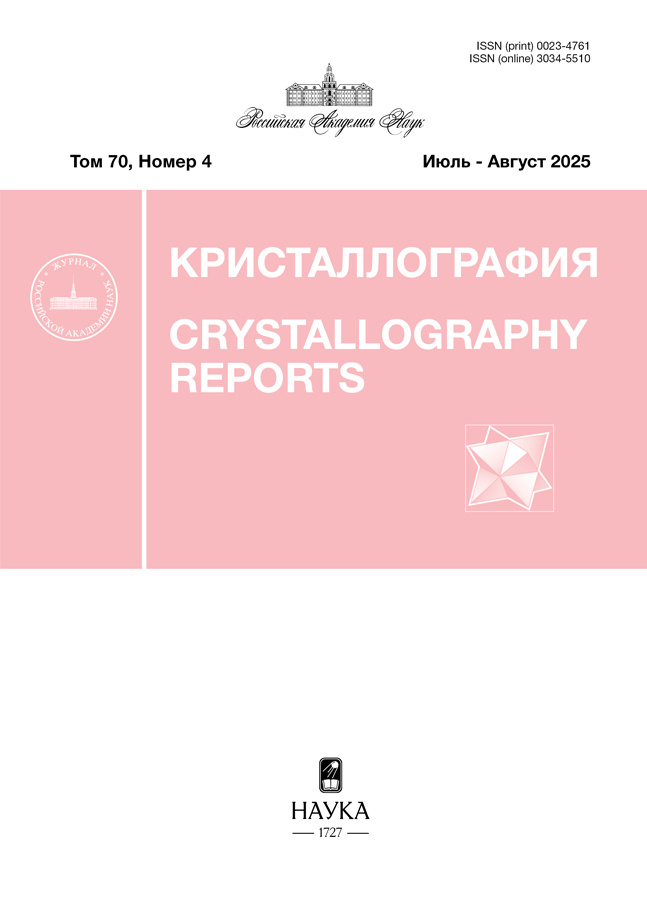Computer diffraction tomography. Digital image processing and analysis based on the 1D-, 2D-sized guided and wavelet-function filter processing
- 作者: Bondarenko V.I.1, Rekhviashvili S.S.1, Chukhovskii F.N.1,2
-
隶属关系:
- National Research Center “Kurchatov Institute”
- Kabardin-Balkar Scientific Center of Russian Academy of Sciences
- 期: 卷 70, 编号 4 (2025)
- 页面: 552–559
- 栏目: ДИФРАКЦИЯ И РАССЕЯНИЕ ИОНИЗИРУЮЩИХ ИЗЛУЧЕНИЙ
- URL: https://clinpractice.ru/0023-4761/article/view/688071
- DOI: https://doi.org/10.31857/S0023476125040029
- EDN: https://elibrary.ru/JEWKKG
- ID: 688071
如何引用文章
详细
One presents and analyzes the results of computer processing for a plane-wave X-ray topography imaging of a point defect of the Coulomb-types in the Si(111) crystal recorded by an X-ray detector against a background of the Gaussian noise, and their subsequent filtering by using the 1D-, 2D-sized guided and a heuristic wavelet 4th-order Daubechie’s atomic function. The filtering efficiency of a topography image is determined by the parameter of the averaged over all pixels relative square deviations of the pixel intensities (RMS.) of the processed and reference (noise-free) 2D image. Practical methods for selecting filtration parameters are proposed, using which the considered methods work well enough to be used in practice for the noise processing of plane-wave X-ray topography images, meaning their use for the 3D digital recovering nanosized crystal defects.
全文:
作者简介
V. Bondarenko
National Research Center “Kurchatov Institute”
编辑信件的主要联系方式.
Email: bondarenko.v@crys.ras.ru
Shubnikov Institute of Crystallography of the Kurchatov Complex Crystallography and Photonics
俄罗斯联邦, MoscowS. Rekhviashvili
National Research Center “Kurchatov Institute”
Email: bondarenko.v@crys.ras.ru
Shubnikov Institute of Crystallography of the Kurchatov Complex Crystallography and Photonics
俄罗斯联邦, MoscowF. Chukhovskii
National Research Center “Kurchatov Institute”; Kabardin-Balkar Scientific Center of Russian Academy of Sciences
Email: bondarenko.v@crys.ras.ru
Shubnikov Institute of Crystallography of the Kurchatov Complex Crystallography and Photonics, Institute of Applied Mathematics and Automation
俄罗斯联邦, Moscow; Nalchik参考
- Authier A. Dynamical Theory of X-ray Diffraction. New York: Oxford University Press, 2001. 680 p.
- Asadchikov V., Buzmakov A., Chukhovskii F. et al. // J. Appl. Cryst. 2018. V. 51. P. 1616. https://doi.org/10.1107/S160057671801419X
- Бондаренко В.И., Конарев П.В., Чуховский Ф.Н. // Кристаллография. 2020. Т. 65. № 6. С. 845. https://doi.org/10.31857/S0023476120060090
- Chukhovskii F.N., Konarev P.V., Volkov V.V. // Acta Cryst. A. 2020. V. 76. P. 16. https://doi.org/10.1107/S2053273320000145
- Hendriksen A.A., Bührer M., Leone L. et al. // Sci. Rep. 2021. V. 11. P. 11895. https://doi.org/10.1038/s41598-021-91084-8
- Chukhovskii F.N., Konarev P.V., Volkov V.V. // Crystals. 2024. V. 14. P. 29. https://doi.org/10.3390/cryst14010029
- Бондаренко В.И., Рехвиашвили C.Ш., Чуховский Ф.Н. // Кристаллография. 2024. Т. 69. № 5. С. 755. https://doi.org/10.31857/S0023476124050012
- Welstead S. Fractal and Wavelet Image Compression Techniques. SPIE Publications, 1999. 254 p.
- He K., Sun J., Tang X. // IEEE Trans. Pattern Anal. Machine Intell. 2013. V. 35. № 6. P. 1397. https://doi.org/10.1109/TPAMI.2012.213
- Nagajyothi G., Raghuveera E. // Int. J. Adv. Res. Electron. Commun. Eng. 2016. V. 5. P. 2362.
- Li Z., Zheng J., Zhu Z. et al. // IEEE Trans. Image Process. 2015. V. 24. P. 120. https://doi.org/10.1109/TIP.2014.2371234
- Zhang Y.Q., Ding Y., Liu J. // IET Image Process. 2013. V. 7. № 3. P. 270. https://doi.org/10.1049/iet-ipr.2012.0351
- Zhu S., Yu Z. // IET Image Process. 2020. V. 14. № 11. P. 2561. https://doi.org/10.1049/iet-ipr.2019.1471
- Малла С. Вейвлеты в обработке сигналов. М.: Мир, 2005. 671 с.
- Гонсалес Р., Вудс Р. Цифровая обработка изображений. М.: Техносфера, 2005. 1072 с.
- Дремин И.М., Иванов О.В., Нечитайло В.А. // Успехи физ. наук. 2001. Т. 171. № 5. С. 465. https://doi.org/10.3367/UFNr.0171.200105a.0465
- Уэлстид С. Фракталы и вейвлеты для сжатия изображений в действии. М.: Триумф, 2003. 320 с.
补充文件















